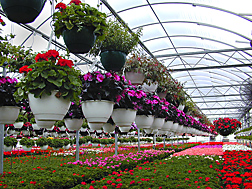This page has been archived and is being provided for reference purposes only. The page is no longer being updated, and therefore, links on the page may be invalid.
|
Read the magazine story to find out more. |
|
|
|
|
Can the Right Potting Mix Replace Fungicide?
By Don ComisJune 15, 2007
Potting mixes custom-tailored to fight plant diseases can work much better than systemic fungicides.
Agricultural Research Service (ARS) plant pathologists Leona Horst, James Locke and Charles Krause found this was true for a mix of peat, compost and the beneficial fungus Trichoderma hamatum strain 382. Horst and Krause are at the ARS Application Technology Research Unit in Wooster, Ohio. Locke is part of the unit's relatively new Greenhouse Production Research Group in Toledo, Ohio.
In a test with begonias, the scientists found that the mix reduced Botrytis gray mold, caused by the Botrytis cinerea fungus, better than the standard fungicide chlorothalonil did. Botrytis gray mold is the most common disease of greenhouse floral crops such as begonia, carnation, chrysanthemum, cyclamen, geranium, impatiens, petunia and marigold.
The beneficial Trichoderma fungus seems to enter the plants through the roots and spread through the entire plant internally. One advantage of systemic biocontrol—as opposed to spraying the plant leaves with a solution containing beneficial fungi—is that it doesn't leave a residue on the plant that harms plant market value.
Begonias grown in this mix had much fewer gray mold symptoms and much higher market value that those grown in straight peat and sprayed with chlorothalonil. The improvement in plant quality and market value makes the Trichoderma-compost mix very promising for greenhouse operations. Also, Botrytis has developed resistance to several fungicides.
The Trichoderma fungus thwarts Botrytis on more than one front. It prevents Botrytis from infecting fresh wounds, and produces compounds that keep Botrytis spores from germinating.
Surprisingly, the compost mix had a similar effect even without Trichoderma. This means there could be naturally occurring beneficial fungi or other biocontrol agents in the compost.
But, growers need to add beneficial fungi like Trichoderma to their mix, because they can't count on commercial composts to have them naturally.
Read more about the research in the May/June 2007 issue of Agricultural Research magazine.
ARS is the U.S. Department of Agriculture's chief scientific research agency.

